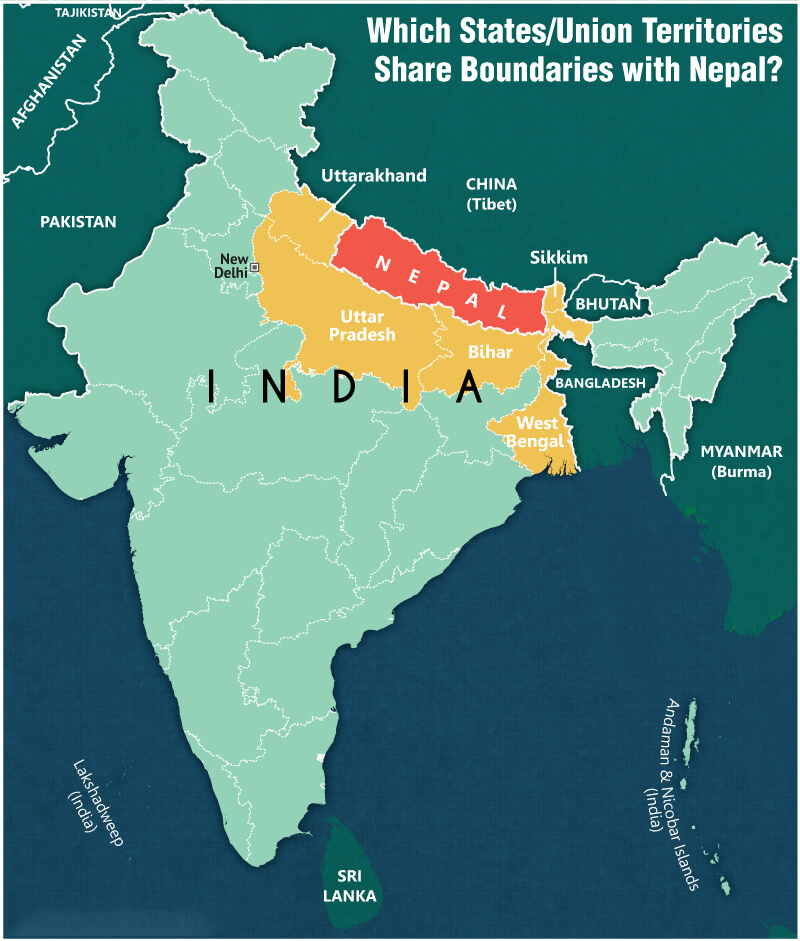International Relations
India-Nepal Power Pact
- 16 Jan 2024
- 7 min read
For Prelims: India-Nepal Power Pact, India-Nepal Treaty of Peace and Friendship of 1950, Surya Kiran, Mahakali Treaty, Kalapani-Limpiyadhura-Lipulekh trijunction.
For Mains: Major Areas of Cooperation Between India and Nepal, Major Challenges to India Nepal Relations.
Why in News?
India and Nepal recently signed a long-term agreement for the export of power. The agreement was inked during the 7th meeting of the Nepal-India Joint Commission, highlighting the strengthening ties between the two nations.
What are the Key Takeaways From the 7th Meeting of the Nepal-India Joint Commission?
- Power Export Agreement: India and Nepal signed a bilateral agreement for the export of 10,000 MW of power in the next 10 years.
- Cross-Border Transmission Lines Inauguration: Three cross-border transmission lines were jointly inaugurated including the 132 kV Raxaul-Parwanipur, 132 kV Kushaha-Kataiya, and New Nautanwa-Mainahiya lines.
- Renewable Energy Cooperation: A Memorandum of Understanding (MoU) was signed between the Nepal Electricity Authority and India's National Thermal Power Corporation Limited for cooperation in renewable energy.
- Agreement for Satellite Service : The Service Agreement for Munal Satellite developed by Nepal Academy of Science and Technology between Nepal Academy of Science and Technology and NewSpace India Limited was launched.
- This satellite developed by Nepali students shall be launched on a gratis basis on an Indian launch rocket.
What are the Major Areas of Cooperation Between India and Nepal?
- About:
- India and Nepal, being immediate neighbors, enjoy special bonds of friendship and collaboration marked by an open border and strong people-to-people connections rooted in kinship and culture.
- Nepal shares a border of over 1850 km with five Indian states – Sikkim, West Bengal, Bihar, Uttar Pradesh and Uttarakhand.
- The India-Nepal Treaty of Peace and Friendship of 1950 forms the bedrock of the special relations that exist between India and Nepal.
- Economic Cooperation: India is Nepal's largest trade partner and the largest source of foreign investments, besides providing transit for almost the entire third country trade of Nepal.
- India accounts for about two-third of Nepal’s merchandise trade and about one-third of trade in services.
- Recently, India and Nepal agreed to review the Treaty of Transit and the Treaty of Trade, proposed amendments to existing agreements, strategies for enhancing investment, the harmonization of standards and the synchronized development of trade infrastructure.
- India accounts for about two-third of Nepal’s merchandise trade and about one-third of trade in services.
- Defense Cooperation: India has been aiding the modernization efforts of the Nepal Army through equipment supply and training provisions.
- The joint military exercise, 'Surya Kiran,' at the battalion level, is conducted in both India and Nepal on a rotational basis.In 2023, it was held in Pithoragarh, Uttarakhand.
- Cultural Cooperation:
- The Embassy of India in Nepal, in collaboration with Lumbini Development Trust and Lumbini Buddhist University organized the inaugural India-Nepal Cultural Festival in Lumbini in December 2023.
- The festival showcased the rich cultural heritage and traditions of India and Nepal, with a focus on Buddhism.
- The Embassy of India in Nepal, in collaboration with Lumbini Development Trust and Lumbini Buddhist University organized the inaugural India-Nepal Cultural Festival in Lumbini in December 2023.
- Water Sharing: The Koshi Agreement (1954, revised in 1966) and Gandak Agreement (1959, revised in 1964) were the initial significant agreements fostering India-Nepal cooperation in the water resources sector.
- Another pivotal pact, the Mahakali Treaty (1996), ensures the fair utilization of Mahakali river, waters for both countries.
- Connectivity: India is assisting Nepal by upgrading 10 roads in the Terai area, establishing cross-border rail links at Jogbani-Biratnagar and Jaynagar-Bardibas, and setting up Integrated Check Posts at key locations such as Birgunj, Biratnagar, Bhairahawa, and Nepalgunj.
- Also, India exported about 2200 MUs of electricity to Nepal in 2021.
What are the Major Challenges to India Nepal Relations?
- Boundary Dispute: The boundary dispute has become a significant source of tension in recent India-Nepal relations, particularly concerning the Kalapani-Limpiyadhura-Lipulekh trijunction area in western Nepal and the Susta area in southern Nepal.
- China’s Rising Footprint: China has provided financial and technical assistance to Nepal in areas such as infrastructure, industrialization, human resources, health, education, and water resources. Rising Nepal and China cooperation can undermine Nepal’s distinction of a buffer state between India and China.
- Gorkhas, traditionally in the Indian Army, might join China's People's Liberation Army (PLA) due to concerns over India's new Agniveer scheme.
Way Forward
- Addressing Immediate Concerns: Prioritize addressing immediate concerns related to the Agniveer Scheme, to build trust and goodwill.
- Develop joint projects for the benefit of border regions, fostering a sense of shared development.
- Diplomatic Dialogue: Engage in sustained and open diplomatic discussions to address the boundary dispute and other contentious issues..
- Track-II Diplomacy: Encourage Track-II diplomacy involving non-governmental entities, academics, and civil society to provide a new shape to India Nepal Cooperation.
UPSC Civil Services Examination Previous Year Question (PYQ)
Q. Consider the following pairs: (2016)
Community sometimes In the affairs of mentioned in the news
- Kurd — Bangladesh
- Madhesi — Nepal
- Rohingya — Myanmar
Which of the pairs given above is/are correctly matched?
(a) 1 and 2
(b) 2 only
(c) 2 and 3
(d) 3 only
Ans: (c)





